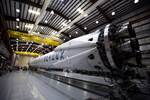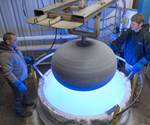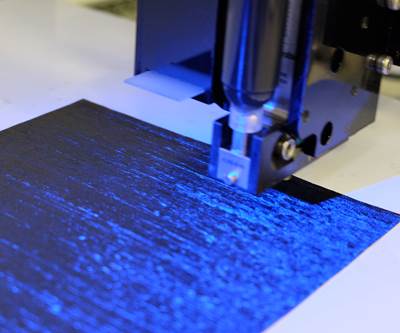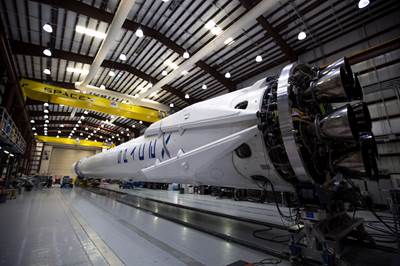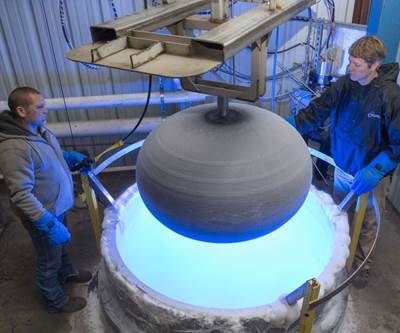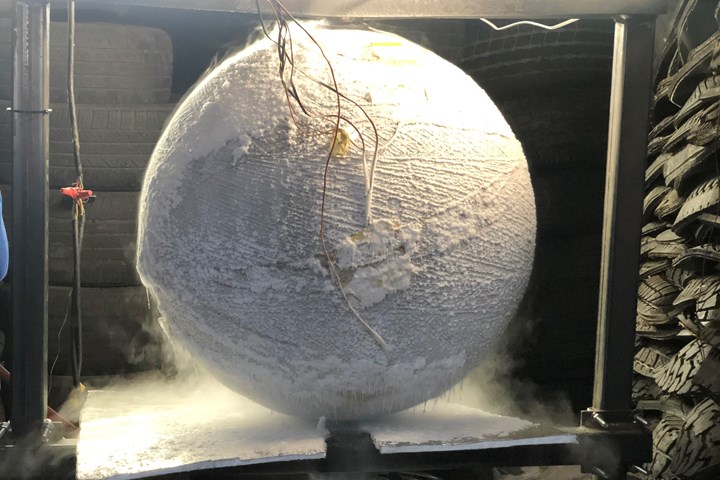
The linerless, carbon fiber/epoxy CryoSphere is manufactured via filament winding and industrial oven cure at Infinite Composites Technologies’ Oklahoma facility. Source | ICT
Launch vehicles for space travel require a lot of fuel, and a lot of fuel storage. Typical rocket propellants such as oxygen, hydrogen and nitrogen can be stored as gases at room temperature, but since gases are relatively low density, storing enough gas propellants for a space launch would necessitate very large tanks, adding to the weight of the spacecraft and limiting its payload capacity. These propellants, then, are ideally stored at higher density as liquids, enabling the use of smaller and fewer tanks in which to store them, but many common propellants must be chilled to ultra-cold temperatures (also known as cryogenic, and generally referring to temperatures below -150°C, or -238°F) to exist as liquids.
To this end, in April 2020, Infinite Composites Technologies (ICT, Tulsa, Okla., U.S.) announced its development of a spherical, linerless, all-composite cryotank — a pressure vessel for storing cryogenic propellants on rocket-powered space launch vehicles.
Linerless — also known as Type V — pressure vessels have long been a goal in designing carbon fiber composite high-pressure storage tanks. Traditionally, pressure vessels of Types I through IV have incorporated a metal or plastic lining between the stored gas or liquid and the composite exterior. Eliminating this lining significantly reduces the weight of the tank, leading, in the case of fuel storage tanks for spacecraft, to either reduced costs of launching the vehicle or increased payload capacity.
All-composite cryogenic storage tanks are considered a key enabling technology for long-term exploration and survival in space.
However, all-composite designs for cryogenic fuels like liquid nitrogen or liquid oxygen tend to cause the elusive problem of microcracking in the laminate. As a composite laminate faces exposure to extreme temperatures such as cooling to cryogenic levels, the difference in coefficients of thermal expansion (CTE) between each ply can lead to cracking and leaks. Many resin systems also become brittle at cryogenic temperatures, exacerbating the issue. According to ICT’s CEO Matt Villarreal, Infinite Composites Technologies has developed a linerless cryotank that eliminates the microcracking issues.
According to Villarreal, all-composite cryogenic storage tanks — spherical ones, in particular, due to their smaller footprint — are considered by many to be a key enabling technology for long-term exploration and survival in space. Though many lunar landers in development by space agencies such as NASA incorporate a spherical tank design, he says, up to now spherical tanks have all been heavier, less fuel-efficient metallic spheres or spherical metallic composite-overwrapped pressure vessels (COPV). ICT’s all-composite tank, called the CryoSphere, offers potential for a lighter, more fuel-efficient option to store fuel.
From racecars to rockets
Before cryotanks were part of the picture, Villarreal and business partner Michael Tate started their careers in composite pressure vessel design while in college at Oklahoma State University (Stillwater, Okla., U.S.). In 2008, they joined the school’s small Formula SAE team, which was working on a design for a quarter-scale Formula One-style vehicle to compete in an upcoming international event of Formula SAE’s collegiate engineering and design competition. To attract much-needed funding from local natural gas companies, Villarreal and Tate helped convert the team’s vehicle to run on compressed natural gas (CNG), but found that the all-metal CNG storage tank they used was so heavy that it affected the car’s fuel efficiency to the point that they had to refuel the car many times over the course of the competition’s 24-hour endurance trial.
“After the race, we went back and did some research, and found out that tank mass was a major problem across many different industries, and was a key enabling technology for both clean energy for transportation and space exploration,” Villarreal says.
During their research into technologies that facilitate lighter CNG tanks, Villarreal says that he and Tate started thinking about concepts for the Type V, linerless composite tanks hailed in the industry as the “Holy Grail” of pressure vessels. Later in 2008, Villarreal and Tate started a company called CleanNG LLC to, initially, develop high-pressure tanks for natural gas storage. Since 2013, the company’s cylindrical, all-carbon fiber composite infiniteCPV pressure vessel has been used in ground-based and industrial applications to store, as initially designed, compressed natural gas, and also, increasingly, compressed krypton, nitrogen and helium gases as well.
As the company continued work on its pressure vessel design, Villarreal says, firms building space vehicles began reaching out to CleanNG with research and development funding to develop versions of their tanks for use on spacecraft. “After awhile, the business case became more attractive for space,” Villarreal says.
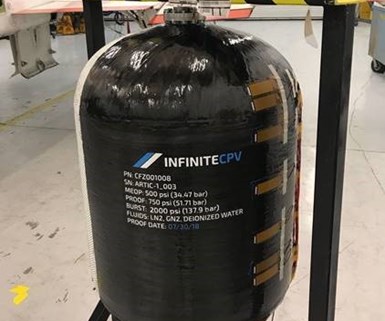
In fall 2019, Applied Graphene Materials announced that its graphene technology has been incorporated into two ICT resin systems for cryogenic pressure vessels being considered for use in NASA spaceflight missions. Source | Applied Graphene Materials
In 2016, the company changed its name to Infinite Composites Technologies, and in the years since, ICT has focused primarily on commercial space projects, though Villarreal says the company also works on defense applications such as rocket motor casings as well as military aircraft and unmanned aerial vehicles. As part of this transition, the cylindrical infiniteCPV tank design has been integrated into several rocket launch vehicles expected to fly in 2020.
The CryoSphere, Villarreal says, is essentially an evolution of the original infiniteCPV tank.
Developing the CryoSphere
As ICT’s focus turned more and more toward the needs of spacecraft, Villarreal says: “We began to see a trend that the real challenge was making composite cryotanks.” Cryogenic tanks, or cryotanks, are pressure vessels specially designed to withstand not just high pressures but also extreme low temperatures, such as the sub-200°F temperatures required for storage of liquid nitrogen, liquid oxygen, liquid methane or other fuels and oxidizers used to power space launch vehicles.
The company applied for funding from the state of Oklahoma, and received a three-year, $300,000 grant from the Center for the Advancement of Science and Technology (OCAST) in 2013 for material characterization and materials-level testing of a cryotank concept. “The project was moderately successful,” Villarreal says. “We found some good material candidates and had a good indication that we could move forward with the concept and start applying for other things.”
ICT pitched its cryotank concept to NASA’s Johnson Space Center (Houston, Texas, U.S.) in 2018, and later started a rapid development project for a composite cryotank to be used in a lunar lander demonstration vehicle — a vehicle that was, Villarreal says, similar to NASA’s previous Morpheus vertical takeoff and vertical landing (VTVL) test vehicle. Performance requirements of the tank included the ability to withstand 10 cycles of liquid nitrogen (LN2) at a pressure of 100 psi, involving a drop in temperature down to -290°F and then back to ambient temperature. In addition, the tank could not drop more than 10 psi during a 30-minute helium check between each LN2 cycle, and it needed to withstand a post-cycle cryo burst of 1,000 psi (±100 psi).
The first round of testing on a cylindrical cryotank was a partial success, surviving only five cryogenic cycles. “We accelerated the project, and basically turned around the design in about eight weeks,” Villarreal says. “It was a mad rush,” he admits, “and the tank survived a couple of thermal cycles, but then it started to leak.” The problem was microcracking in the laminate. The team finished the testing and then “went back to the drawing board,” Villarreal says.

During testing, the CryoSphere is surrounded by sandbags and blast mats made from recycled tires for blast mitigation. Source | ICT
“The core technology is in the materials,” says Efren Luevano, ICT’s engineering manager. The CryoSphere is made of Toray (Tokyo, Japan) T800 carbon fiber and an epoxy resin, and manufactured via filament winding, cured at room temperature, and post cured in an industrial oven (as opposed to an autoclave) at ICT’s Tulsa facility.
Trying to solve the microcracking dilemma, ICT began iterative testing of several types of additives within a proprietary, chemically-toughened epoxy resin matrix, in different concentrations. In the process, the team discovered a combination of two additives that, when the tank was tested again, allowed the design to meet thermal requirements. One of these is graphene.
“For this case, we’re using graphene as a mechanical reinforcement on the nanoscale,” Villarreal says. He explains that the graphene platelets, supplied by Applied Graphene Materials (Cleveland, U.K.), stretch across the space between the fibers and create an obstacle for cracks to form in the laminate. The graphene also improves the strength of the bonds between the layers.
“What you’re trying to do is keep the fibers in place as you pressurize the tank and apply the load to the tank,” Villarreal explains. At low temperatures, the resin becomes brittle and starts to fracture — as pressure is added to the fibers, they begin to slide across each other and break the chemical bonds between them, he says. The graphene platelets act as a mechanical reinforcement between the fiber layers, reducing the likelihood of movement and fracture.
An additional proprietary additive is also incorporated into the matrix, making the laminate more ductile at low temperatures and creating more insulative properties in the laminate. In addition to microcracking, “[insulation is] one of the challenges of these cryotanks,” Villarreal says. In testing, the new CryoSphere design incorporating the graphene-enhanced resin took almost an hour with liquid nitrogen in it “to show outward signs of cold.” Though there was no particular requirement for this, he adds that on previous tanks they’d tested with liquid nitrogen, frost had formed on the external tank surface within 10 minutes of filling the tank with liquid nitrogen.
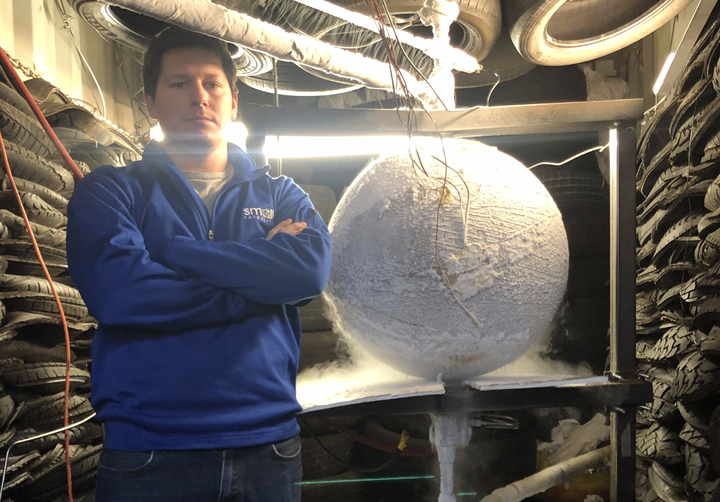
The CryoSphere has been developed to store liquid propellants at cryogenic temperatures as low as -290°F. Source | ICT
In addition to the cryogenics compatibility, Luevano adds that the spherical design was a challenge in itself. According to Villarreal, the benefit of the spherical shape is that it enables better packing efficiency for applications with tight or specific size requirements, such as lunar landers. However, one challenge was that potential for slippage during manufacture was greater on a spherical surface compared to a cylindrical surface, which Villarreal says was due to both the needed winding angle and that the surface finish on the mandrel didn’t create enough friction to keep the wet impregnated fibers in place – both of which made fiber control and laydown more difficult. Another challenge was that the pattern design software the team used was optimized for cylinders, and could not generate feasible patterns for the sphere using normal workflow. “We had to get creative with workarounds,” he adds.
The spherical design also helped with the microcracking issue — an unintentional benefit, Villarreal says. The team realized in an early design iteration that there was about a 150°F difference in temperature between the bottom of the tank and the top of the tank, caused by the hour-long filling process whereby liquid nitrogen was sitting on the bottom of half of the tank at -290°F while gaseous nitrogen filling the upper half was only at -140°F. “When you get those very sharp gradients in temperature in the laminate, it can cause fractures, because one part’s trying to stretch at a different rate than another part,” Villarreal says. That gradient between the top and bottom of the tank is lessened with a smaller, spherical shape, helping to decrease the temperature disparity.
New, optimized design in hand, ICT signed a contract in late 2019 with NASA’s Kennedy Space Center (Cape Canaveral, Fla., U.S.) to deliver two spherical, cryogenic tanks for testing that were half the scale of the cylindrical Morpheus lander tanks. “Our CryoSpheres completed all of the thermal cycle testing with helium checks in between each cycle to make sure that microfractures hadn’t developed,” Villarreal says. “To our knowledge,” he adds,” there were three other vendors vying for this contract, but by the time we’d completed testing, none of the other vendors had even created their first prototypes yet.”
Next steps toward spaceflight
Tests are ongoing. ICT also received funding for NASA’s MISSE program, which launches materials to the International Space Station (ISS) for experimental purposes. For this, ICT created spheres that are two and a half inches in diameter — a size developed primarily for testing purposes but that Villarreal adds could be used in applications such as pneumatic systems for robots. “They look oddly like tiny grenades,” he notes. ICT delivered five of these CryoSpheres to NASA’s Langley Advanced Research Center (Hampton, Va., U.S.) in February 2020. The MISSE launch to the ISS was initially planned for August 2020, but has been delayed until probably November, Villarreal says. Once delivered to the ISS, the CryoSpheres will be placed on the outside of the station and studied for about six months with radiation sensors attached to them, to test the materials’ endurance when exposed to heat and radiation while orbiting the Earth and being exposed directly to the sun. If these tests are successful, ICT will receive the CryoSpheres back for additional cryogenic testing and to assess the effects of radiation exposure on the materials. Of primary concern is how chemical bonds in the resin might be impacted.
After that, Villarreal says, the next step is flight qualification. He says that ICT has already completed about half of the qualification testing using a tailored version of the American Institute of Aeronautics and Astronautics (AIAA) S-081B standard, and anticipates that the remainder of the testing will be completed by the end of the third quarter of 2020.
The company also plans to scale the tank size up to 48 inches in diameter, the size specified for commercial lunar landers in development by NASA, and is working on partnerships to send the CryoSphere to the moon.
“Our team is expanding the limits of what is possible with all-composite tanks,” concludes Villarreal. “This technology has the potential to revolutionize space exploration and sustainable transportation.”
Related Content
Carbon fiber, bionic design achieve peak performance in race-ready production vehicle
Porsche worked with Action Composites to design and manufacture an innovative carbon fiber safety cage option to lightweight one of its series race vehicles, built in a one-shot compression molding process.
Read MorePlant tour: Spirit AeroSystems, Belfast, Northern Ireland, U.K.
Purpose-built facility employs resin transfer infusion (RTI) and assembly technology to manufacture today’s composite A220 wings, and prepares for future new programs and production ramp-ups.
Read MoreJeep all-composite roof receivers achieve steel performance at low mass
Ultrashort carbon fiber/PPA replaces steel on rooftop brackets to hold Jeep soft tops, hardtops.
Read MorePlant tour: Albany Engineered Composites, Rochester, N.H., U.S.
Efficient, high-quality, well-controlled composites manufacturing at volume is the mantra for this 3D weaving specialist.
Read MoreRead Next
Nanomaterials: Products, supply chain mature for next-gen composites
Development spans 3D and thermoplastic nanocomposites, nano-CMCs for hypersonics and nanomaterials safety and toxicity.
Read MoreNext-generation pressure vessels in space
After a name change, next on the horizon for Infinite Composites Technologies is supplying Type V tanks to the space race.
Read MoreCarbon fiber composite liner-less pressure tank handles cryogenic temps
Cimarron Composites has made a leap forward in all-composite cryogenic tank development.
Read More

.jpg;width=70;height=70;mode=crop)

